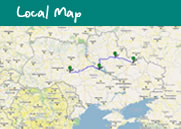You are here:
- Home
- Where are we?
- Vinnitsa
- Area Profile
Area Profile - Vinnitsa
-
What is the history of the Jewish community?
- The emergence of the Jewish community
- The Jewish community before the Revolution
- Early Soviet period
- The Holocaust years
- Post-war situation
- The revival of the Jewish community
- What should I see there?
- Where can I feel the Jewish spirit?
- Are there any historically significant people?
- What is the lifestyle of the modern local community like?
- Where can I eat delicious kosher food?
- The things worth spending money on
- What should I bring back home with me?
- What is the best way for me to get there?
- Where should I stay?
- What should I read and see?
- Whom can I contact with any questions?
- What should I pack for my trip?
- Useful vocabulary
Time of Jewish Community emerged.
The community before the revolution
Early Soviet period
The years of The Holocaust
Years after the War
Vinnytsa had been built as a fortress to defend from nomadic raids from the Dikoe Pole (Wild Field) side. Starting 1400 till 1569 it was subjected to attacks and then rebuilt more than thirty times. City is located on the trade route between Moldova and Moscow. It was rapidly growing, and starting second half of the XV century, received a status of Magdeburgskoe Pravo.
From 1598 Vinnytsa is the center of Bratslavskoye Voyevodstvo of Rech Pospolitaya, having an important role in the economic life of the area.
First time Jews were mentioned for in the city in 1532. There were 50 Jews in Vinnytsa according to census of 1616.
Until the middle of the XVIII century the life of the city was never calm: Tatar raids and Gaydamaky revolts, war of Bogdan Khmelnitsky with Poland and further multiple division of land made Vinnytsa at some point of time a part of Ukrainian Kosaks land, at some point of time under the Poland Crown jurisdiction, and even as a part of Turkish territory (Sarmatskoye Kingdom – 1672 - 1699).
All these years Jews lived in Vinnytsa: in 1765 – 348 Jews in the city, in 1776 after plague epidemic – only 190, and in 1787 – 691 Jews. In accordance with lustration of 1789 Jews owned 53 inns and 27 other places, 82 back houses and 9 houses in the new part of the city. Their main occupation was a grossary trade.
A documented proof of a Jewish community unification can be dated as a second half of the XVII century. Hevra-Kadisha was emerged in the city by 1654. There was also found Pinkas of Burial Society. The first record of this document is dated 1727 and the last one 1890. The oldest Bolshaya (Big) Synagogue is mentioned under the records of 1731, and synagogue in the "New City" - under 1898.
After Poland second division in 1793 and its territories were annexed by Russia, Vinnytsa became an administrative center. Jewish community was growing along with the growing city. By the year 1863 there were already 3633 Jews in the city. Due to a newly constructed railroad Kiev-Balta-Odessa not far from the city in 1870 a connection with Kiev, Odessa, Moscow and Saint Petersburg became much easier. For the next 40 years Vinnytsa took the first place in Podolskaya gubernia at freight.
In less then 30 years Jewish population of Vinnytsa increased three times: according to census of 1897 Jews outnumbered other nationalities (37.48%). They were ahead of Ukrainians (35.54%), Russians (17.03%), Polls (7.11%). Tailors and traders of agricultural goods were the most common occupations.
At the beginning of the XIX century there were 2 synagogues and 12 praying houses, 2 Talmud-Torah, Jewish Schools, hospitals, starting 1894 – a shelter for the elderly people in the hospital.
Since October 18 and up to October 29 of 1905 bloodshed pogroms swamped Vinnytsa and its region.
"Victims of Jewish pogroms were left out without any possession; part of it was destroyed, part was ruined, part was stolen", - as it was noted by general-governor of Kiev, Podolsk and Volinsk.
1917 -1920 in Vinnytsa as in Ukraine in general – is a time of a regimes change. As everywhere else, Jewish population suffered from taxation, robberies and pogroms. The most massive pogrom happened August 30, 1919. Soviet order was finally established in June of 1920.
In 1920’s – 1930’s the population of Vinnytsa grew higher and so did Jewish population. As a result of a Military Communism policy which weakened small private enterprises and skillful people craftsmanship, a level of life dramatically decreased.
People started leaving a country side and villages for cities. The Jews from the foreign countries organizations came to help Ukrainian Jews. The first one was "Joint" organization. But their abilities were limited.
As well as through the whole Ukraine in autumn of 1932 – winter-spring 1933 it was a hunger period in Ukrainian small towns and villages. County Party Committee of Vinnytsa in March of 1933 reported to Communist Party Central Committee (of Bolsheviks) of Ukraine, that "in county's small towns and villages there were a number of occurrences of people swelling because of lack of food and hunger".
Since in 1926 there were a significant number of Jews in the city, as a part of a young Soviet State project, there was a publication of newspaper in Yiddish in Vinnytsa "Prolitarisher Emes". There was Jewish Teachers University, Jewish elementary and middle schools, libraries. In 1929 a Jewish department of working youth was established. Alongside the fight with Judaism was gradually on a rise. At the beginning of 1930's this fight took a total turn. By the year 1931 in Vinnytsa lived about 22,000 Jews, and only 2 praying houses survived.
By the end of 1930's the policy of national and cultural equality started coming to an end. However, even in 1939 in Vinnytsa county 73.5% of Jewish population named Yiddish their native language.
By the end of 1930's many of Jewish communists were sentenced by Stalin's repressions.
In 1939 Jewish population of Vinnytsa reached 33,150. Before the Nazi invasion part of population managed to get evacuated, and about 9500 were drafted for military service.
In July 19 of 1941 city get occupied by German troops. Jews were isolated in ghettos, and Yudenrat was created. Mass killing started July 28, persisted in August and by September 22 of 1941 a majority of prisoners of Vinnytsa ghetto were exterminated. Only people of different trades and technical workers, whose labor was needed for German authorities, stayed alive. But by the end of 1942 even these people were not needed any longer…
The roads paved by the prisoners of war and local Jews are in use even now, and residents of Vinnytsa communicate with Germany using a telephone cable installed by Jewish prisoners-technicians to Hitler's headquarter "Werwolf".
In March of 1942 Jerusalimka – a Jewish block (kvartal) of Vinnytsa had been bulldozed, and the remnants of the houses were used by Nazis for the pavement of roads leading to the bridges across Youzhniy (South) Boog river.
Some of the Jews who managed to survive, participated in the city's underground movement and groups of resistance within the county. Izia Elevich Bendersky was a leader of one of the underground fighters group, which existed until the day of Vinnytsa liberation
After the war Vinnytsa became a big industrial City. In 1959 there were about 19,500 Jews – 16% of city population. They were mainly engineers, technicians, doctors, teachers, shoe-makers, tailors and workers of trade. In 1946 synagogue was re-opened. Three years after, authorities pressed charges against Jewish community that "the law about religious statement was violated" and synagogue was forced to close. But in 1953 it was re-opened again.
According to Census of 1970 there were 42,251 Jews in the county, 17,984 of them lived in Vinnytsa city.
Starting 1971 part of Jews from Vinnytsa applied for emigration to Israel. This was the time when Aliah started. Authorities were afraid that people's intend to leave Vinnytsa will persist. Trying to discourage people from immigration, in 1972 authorities arrested and faultily accused an engineer Itzhuck Shkolnik who wanted to leave for Israel in espionage and anti-Soviet propaganda in favor of Israel. He was sentenced to ten years of imprisonment in a special labor camps with a highly restricted order.
According to census of 1989, there were 15,000 Jews in Vinnytsa.
Many people left Vinnytsa for Israel, Germany, USA and other countries, and by the year 2001 there were only 1700 Jews in the city. However, since 1992 till 2000 and then after 2002 Vinnytsa's mayors were Jews: Dmitriy Vladimirovitch Dvorkis and Vladimir Borisovitch Groisman. Perhaps, it is a fact that Jewish Cemetery were preserved, but also construction work of a residential building was stopped in 2008 on Gleb Uspensky Street – the construction lot could be a possible part of an ancient Jewish cemetery.
In 1992, thanks to the efforts of Isaac Petrovitch Novoseletsky, The Lifshits Synagogue was returned to community. This synagogue was closed in 1929 by local authorities.
There are many organizations in the building of Kosmonavtov 8. In the office number 11 – the Jewish Veterans Organization "Atikva", Chairman Breidboord Isaac Israilevitch. Tel. +38 (0432) 43-11-54. They are open by Tuesdays. A society of ghetto and concentration camps prisoners works there by Wednesday under the leadership of Koifman Grigoriy Yosifovich. Tel. +38 (0432) 54-23-38.
The best way to start your Vinnytsa trip would be the group of defense structures of XVII-XVIII centuries – "Moory".
Among museums, that would introduce you the history and traditions of the region:
- Military-historical museum of air forces of Ukraine;
- Vinnytsa County Land Museum of Local History. Not only a permanent exposition is there, but also future planned expositions are scheduled for display;
- Museum "My Land – Podolye";
- Pottery art museum;
- Vinnytsa county art museum;
There are 120 museums in Vinnytsa and county: 23 of state museums and 97 are amateur museums.
The trademark of Vinnytsa is an arch entrance to the Gorky Central Park of Culture and Recreation, and a water-lift tower in the park of Kazitsky. This tower turned 100 years in 2011. During 100 years this tower worked only for a short time according to original design. During the war it served as a watch tower, a fire tower, even people lived there, and starting 1993 the Memorial Fighters Museum of Vinnytsa county and those who died in Afghanistan in 1979-1989.
There are many places of interest in the city. Some of them are:
- House of a military commander and a teacher Aleksey Alekseevitch Brusilov;
- Palace of Polish shlahtichi Groholskie of the XVIII century;
- House of the captain Chetkov beginning of the XX century, built in style of Austrian modern style;
- Group of the buildings and park of the hospital named after Alexander Ivanovich Yushchenko;
- Buildings of the end of XIX – beginning of XX century designed and built by Vinnytsa’s architect Artinov. Artinov's designs became a trademark of Vinnytsa, they decorate Sobornaya street, and some other streets of historical center of the city.
- Talking about a modern time, we have to mention the City Council Building. This building is functioning as "transparent office".
8 kilometers from the city, by the Strizhavka village there is Hitler's "Wervolf" headquarters. It functioned since spring of 1942 till spring of 1944. Hitler was there three times. First time he stayed there several months, Eva Braun was there twice, dictator of Romania Ion Antonesku, dictator of Hungary Nadbaniay Horty, German feld-marshal Erih fon Manshtein were there. German general-feldmarshal Fridrih Paulus was there, and even Stalingrad’s battle had been planned there. According to publication of one German newspaper, Vyacheslav Mikhaylovich Molotov came to this place in 1942. This fact yet to be verified.
Not far from Hitler's headquarters by the Cherepashinci village (30 kilometers North from Vinnytsa), headquarters for reih-marshal German Gering was built. It was called "Shtainbruk" ("Stonecrush").
You might want to visit memorial places:
Survived Jewish cemeteries. They are located at Gleb Uspensky Street and Maksimovich Street;
Memorial to Victims of the Catastrophe;
Lifshits Synagogue erected in 1897.
During the years of Soviet era with a religion heavily regulated this synagogue was converted into club named after Stalin, and in 1942 it was converted into a warehouse which stored the close of the Jewish people who were ordered to undress and killed. After the WWII the building was converted into a symphony hall. In 1992 the building was returned to the Jewish community, and these days it houses not only a synagogue. Many other community organizations found its home under the roof of this renovated building.
Jerusalimka – an old Jewish block (kvartal) not far from the contemporary city center. This area was practically completely rebuilt after the war.
You could also get engaged in Jewish spirit, if you would work in Vinnytsa county (oblastnoy) archive or would just get there for a guided tour. The historians and clerks who work with Jewish archives some times make jokes about their work, saying that they do the favorite Creator's job, by calling and recording people by their names. You can find there archived birth, marriage, divorce and death records, property ownership (titles), court records of Soviet era as well as time period of Nazi occupation. There are names that you can hardly hear these days, and there is a life without comments and fame.
Ivan Bogun (circa 1618-1664) Kazaks colonel, companion-in-arms of Bogdan Khmelnitsky, at the end of 1649 was appointed a colonel of Vinnytsa, city defense commander against the Polish troops in 1651.
Nikolay Ivanovich Pirogov (1810 – 1881) – the founder of the military-field medical surgery and topographical anatomy, fellow member of Sankt-Petersburg Academy of Sciences and several foreign Academies. Last years of his life he spent in his estate "Vishnya" in suburbs of Vinnytsa. Later on this region became a part of Vinnytsa city.
Alexey Alexeevich Brusilov (1853 – 1926) – a military leader and military teacher, cavalry general (starting December 6, 1912), general-adjutant (starting April 10, 1915) chief inspector of cavalry RKKA (1923). He lived in Vinnytsa for several years.
Grigory Grigoryevich Artinov (1860 - 1919) city architect of Vinnytsa (1900 – 1919), was a civil engineer, a title advisor, general-leutenant of the construction committee at the office of military affairs until 1914, and the first chief architect of Vinnytsa. His work significantly effected Vinnytsa architectural image.
Mikhail Mikhailovich Kotsubinsky (1864 – 1913) – a classical writer of Ukrainian literature, social activist. He was born and lived in Vinnytsa.
Alexander Ivanovich Yushchenko (1869 – 1936) an academic, one of the founders of bio-chemistry direction in psychiatry, an author of evolutionary genetics and role of constitution in psychiatry, a talented teacher, civil activist, a member of the Ukrainian Academy of Science. For some time he worked in Vinnytsa.
Anatoly Mikhailovich Kashpirovsky – graduated from Vinnytsa Medical School in 1962, and worked for about 25 years in a psychiatric hospital headed by academic Yushchenko. In 1962-1963 he worked as a doctor in Vinnytsa's Railroad Hospital.
Despite the mass repatriation, Jewish life of Vinnytsa did not vanish. There are following Jewish organizations in Vinnytsa as of today:
- Vinnytsa's Judaic religious community "Habad";
- Vinnytsa's religious progressive Judaism community;
- Vinnytsa's religious Jewish community center "Mishpaha", which unites former prisoners of Nazi camps and righteous of people of the world (Hasidey ummot ha olam);
- City society of the former minor ghetto and concentration camps prisoners and their saviors.
There are classes in Jewish Sunday school "Mehina".
In 1999 a theater studio for juniors "Makor" was established.
Help for Jewish population is provided by Vinnytsa's Jewish charity center "Hesed Emuna" and center of a social-medical help "Emuna".
There are no kosher café in Vinnytsa, about kosher meals you should talk to rabbi Shaul Gorovits in advance.
There is a café "Tet-a-tet" (not kosher) adjacent to the synagogue on Sobornaya Street, 58.
It worth while to spend your money for a tour at local history museum, pottery art museum, estate of Nikolay Ivanovitch Pirogov and Hitler's Headquarters. For the last one you might need to spend some money for a taxi cab, but it worsth it!
We would recommend you to take a ride on a river tram, which is taking of the river bank of Yuozhnuiy Boog.
The market located by the railroad station is one of the cheapest places in the city where you can buy berries, fruits, vegetables, and if you would be lucky to be in the city during sour cherries-strawberries season – this would be the best season in Vinnytsa, a real heaven. Prices there are much lower then in Kharkov or Kiev.
There is a railroad station in the city, a bus station and an airport. So the connections to the big cities of Ukraine, Russia, Belorussia, Bulgaria, Slovakia and Germany are provided.
From Kishinev to Vinnytsa you can take train №151 Kiev-Vinnytsa, as well as some other trains, vans. Time of your trip - is a bout 3 hours.
From Kharkov to Vinnytsa you can take train №115 Kharkov-Truskavets, №349 Kharkov-Ivano-Frankovsk and №126 Debaltsevo-Khmelnitsky.
There are different lists of hotels represented in Internet, for example, in the Reservation Center portal Hotels24.ua.
Just across the street from the synagogue there are two hotels: "Vinnytsa" and "Podolye".
A cheaper option is a hostel "Ria Hotel" located at 4 Frunze Street. You can rent an apartment there on day-by-day basis.
Information about main Vinnytsa Internet-resources is collected on site of a middle Scholl №21.
The most complete collection of Vinnytsa's places of interest with selected commentaries is located on one of the blogs; in addition it can be completed with the information of the Ukraine tour-guide doroga.ua, site Grand Ukraine, site Фотогалерея Винницы, site Vinnytsa Ukraine Tourism, and Kiev Institute of Judaica.
We strongly advise you to read "In the ranks of folk fighters", telling the story about Jewish fighters of Vinnytsa during the WWII. We have to read these materials, to know at least what kind of answer to give those, who think the same way as Vladimir Shcherbitsky (at that time the first Secretary of Central Committee of the Communist Party of Ukraine). On a proposal to change the concept of Babiy Yar memorial in Kiev he answered: "If those people would die in the front battlefields, this would be one case. But if they were killed by machine guns, as they were sheeps… this monument is quite enough for them".
If you are generally interested in the history of the area to start with, approach the employees of regional history department of Vinnytsia regional science library named after Kliment Arkadievich Timiryazev or employees of a local history museum.
If you are interested in the history of the Jewish community, the best consultant and tour guide might be Faina Abramovna Vinokurova, assistant director of National archive of Vinnytsia county.
If you will decide to spend time at the bank of Youzhniy Boog river, your beach accessories will definitely come in handy.
Jerusalimka - administrative district not far from the present-day downtown, former Jewish quarter. After the war it was practically rebuilt all over again.

















 Up to page
Up to page Print version
Print version